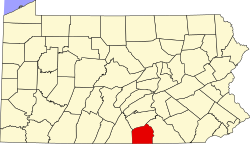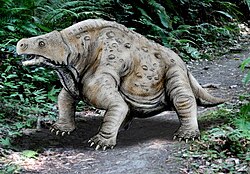
The 20th century in ichnology refers to advances made between the years 1900 and 1999 in the scientific study of trace fossils, the preserved record of the behavior and physiological processes of ancient life forms, especially fossil footprints. Significant fossil trackway discoveries began almost immediately after the start of the 20th century with the 1900 discovery at Ipolytarnoc, Hungary of a wide variety of bird and mammal footprints left behind during the early Miocene. [1] Not long after, fossil Iguanodon footprints were discovered in Sussex, England, a discovery that probably served as the inspiration for Sir Arthur Conan Doyle's The Lost World . [2]
Contents
- 1900s
- 1900
- 1902
- 1903
- 1904
- 1905
- 1906
- 1908
- 1909
- 1910s
- 1910
- 1913
- 1914
- 1915
- 1915-1916
- 1918
- 1920s
- 1920
- 1923
- 1924
- 1925
- 1926
- 1927
- 1928
- 1929
- 1930s
- 1931
- 1932
- 1933
- 1934
- 1936
- 1937
- 1938
- 1939
- 1940s
- 1940
- 1941
- 1943
- 1944
- 1947
- 1948
- 1950s
- 1951
- 1952
- 1953
- 1954
- 1955
- 1957
- 1958
- 1959
- 1960s
- 1960
- 1962
- 1963
- 1965
- 1966
- 1967
- 1968
- 1969
- 1970s
- 1970
- 1971
- 1972
- 1973
- 1974
- 1975
- 1976
- 1977
- 1978
- 1979
- 1980s
- 1980
- 1981
- 1982
- 1983
- 1984
- 1985
- 1986
- 1987
- 1988
- 1989
- 1990s
- 1990
- 1991
- 1992
- 1993
- 1994
- 1995
- 1996
- 1997
- 1998
- See also
- Footnotes
- References
- External links
Several enduring mysteries from the 19th century continued to vex ichnologists, like the identity of the Chirotherium trackmaker. Renowned paleontologist Franz von Nopcsa attributed the ichnogenus to the prosauropod dinosaur Plateosaurus , despite an apparent mismatch between its number of toes (4) and the preserved digit traces of Chirotherium (5). Von Nopcsa explained the discrepancy by arguing that one of the impressions in the Chirotherium tracks was left by a soft tissue structure that did not fossilize. [3] However, it was Wolfgang Soergel who correctly hypothesized that Chirotherium was produced by a distant relative of modern crocodilians. Using only its footprints as a guide he reconstructed the life appearance of the Chirotherium trackmaker. Decades later paleontologists described an animal named Ticinosuchus which precisely fulfilled Soergel's predictions. Ticinosuchus or a close relative seems to have been the true Chirotherium trackmaker. [4]
During the 20th century, many significant fossil trackway discoveries were made in the western United States. In the 1930s and 1940s, Roland T. Bird discovered the tracks of large sauropod and theropod dinosaurs in Texas. He excavated a major section of the track ways on behalf of the American Museum of Natural History. This was the first large scale excavation of fossil footprints in history. [5] In the 1950s Lee Stokes reported unusual footprints he interpreted as the first known pterosaur tracks. [6] This attribution would be controversial much of the rest of the century but has since been vindicated. [7] The dinosaur footprints of Dinosaur Ridge in Colorado were also discovered and studied in the 20th century. [8]
The advent of the dinosaur renaissance and the publication by R. McNeil Alexander of a formula which could reconstruct their running speed based on data from fossil trackways brought renewed interest and prestige to ichnology during the late 20th century. [9] This led to several symposia on the subject of vertebrate trace fossils. In 1986 such a conference dedicated to dinosaur footprints was held in New Mexico. [10] Roughly a decade later renowned German ichnologist Heinrich Haubold organized a conference dedicated to the more ancient footprints of the Paleozoic Era. This gathering has been regarded as a turning point in the study of tracks of that age. [11]


































